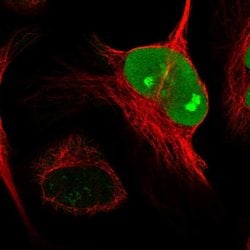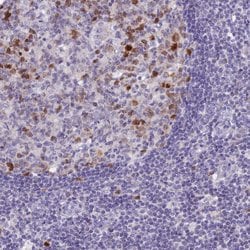Promotional price valid on web orders only. Your contract pricing may differ. Interested in signing up for a dedicated account number?
Learn More
Learn More
Invitrogen™ NUSAP1 Polyclonal Antibody
Rabbit Polyclonal Antibody
Supplier: Invitrogen™ PA560160
Description
Immunogen sequence: KLLKALKGYI KHEARKGNEN QDESQTSASS CDETEIQISN QEEAERQPLG HVTKTRRRCK TVRVDPDSQQ NHSEIKISNP TEFQNHEKQE SQDFRATAKV PSPPDEHQEA ENAVSSGNRD SKV Highest antigen sequence identity to the following orthologs: Mouse - 50%, Rat - 49%.
Ubiquitin: exists either covalently attached to another protein, or free (unanchored). When covalently bound, it is conjugated to target proteins via an isopeptide bond either as a monomer (monoubiquitin), a polymer linked via different Lys residues of the ubiquitin (polyubiquitin chains) or a linear polymer linked via the initiator Met of the ubiquitin (linear polyubiquitin chains). Polyubiquitin chains, when attached to a target protein, have different functions depending on the Lys residue of the ubiquitin that is linked: Lys-6-linked may be involved in DNA repair; Lys-11-linked is involved in ERAD (endoplasmic reticulum-associated degradation) and in cell-cycle regulation; Lys-29-linked is involved in lysosomal degradation; Lys-33-linked is involved in kinase modification; Lys-48-linked is involved in protein degradation via the proteasome; Lys-63-linked is involved in endocytosis, DNA-damage responses as well as in signaling processes leading to activation of the transcription factor NF-kappa-B. Linear polymer chains formed via attachment by the initiator Met lead to cell signaling. Ubiquitin is usually conjugated to Lys residues of target proteins, however, in rare cases, conjugation to Cys or Ser residues has been observed. When polyubiquitin is free (unanchored-polyubiquitin), it also has distinct roles, such as in activation of protein kinases, and in signaling. 60S ribosomal protein L40: component of the 60S subunit of the ribosome. Ribosomal protein L40 is essential for translation of a subset of cellular transcripts, and especially for cap-dependent translation of vesicular stomatitis virus mRNAs.
Specifications
| NUSAP1 | |
| Polyclonal | |
| Unconjugated | |
| NUSAP1 | |
| 2610201A12Rik; AI481307; ankt; AW547774; BB165529; BM037; BM-037; fb76a01; fi37a11; hypothetical protein; LNP; nucleolar and spindle associated protein 1; nucleolar and spindle-associated protein 1; nucleolar protein ANKT; NuSAP; NUSAP1; PRO0310; PRO0310p1; Q0310; SAPL; sb:cb490; Unknown (protein for IMAGE:7053642); Unknown (protein for MGC:134490); wu:fb76a01; wu:fi37a11; YF-9 | |
| Rabbit | |
| Antigen affinity chromatography | |
| RUO | |
| 51203 | |
| Store at 4°C short term. For long term storage, store at -20°C, avoiding freeze/thaw cycles. | |
| Liquid |
| Immunohistochemistry (Paraffin), Immunocytochemistry | |
| 0.8 mg/mL | |
| PBS with 40% glycerol and 0.02% sodium azide; pH 7.2 | |
| Q9BXS6 | |
| NUSAP1 | |
| Recombinant protein corresponding to Human NUSAP1. Recombinant protein control fragment (Product #RP-102189). | |
| 100 μL | |
| Primary | |
| Human | |
| Antibody | |
| IgG |
Product Content Correction
Your input is important to us. Please complete this form to provide feedback related to the content on this product.
Product Title
Spot an opportunity for improvement?Share a Content Correction





